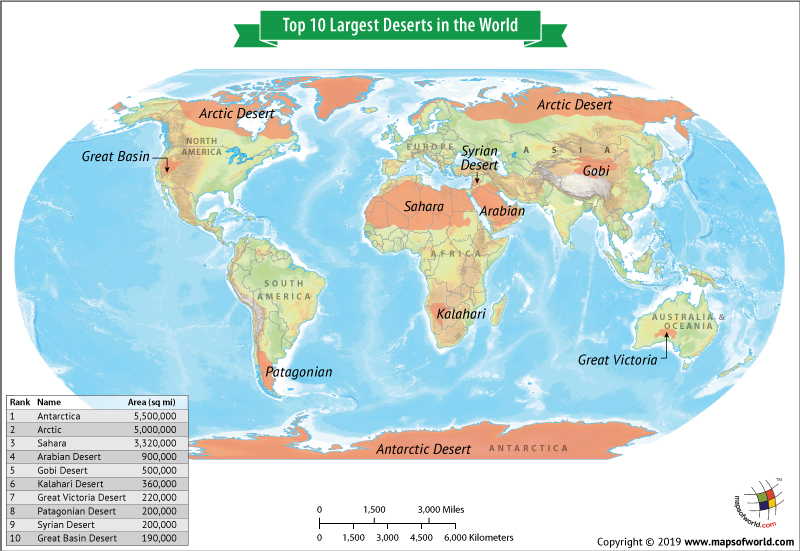Biggest Desert in the World

Deserts can be found in all the continents of the world, and vary in average temperatures from extreme cold to extreme heat. Any area receiving less than 10 inches, or 250 mm of precipitation is classified as a desert.
The 10 largest deserts in the world by size are:
1. Antarctic: 5,500,000 sq. miles
The Antarctic is located in the southern hemisphere and is covered by around 7.1 million cubic miles of an ice sheet that is approximately 1.5 miles thick. With a humidity rating of 5%, it is the driest region on the planet, and so, the Antarctic is classified as a large barren cold desert.
2. Arctic: 5,000,000 sq. miles
The Arctic is the second largest desert on the planet and is slightly smaller in size than the Antarctic. The top part of the Arctic region, known as the Arctic Circle, receives minimal precipitation and is classified as desert land. The southern region of the Arctic, also known as Tundra, has greater precipitation and therefore, supports a thriving ecosystem. A large part of the Arctic is sea ice, most of it seasonal.
3. Sahara: 3,320,000 sq. miles
The Sahara is the third largest desert and is part of a high-temperature zone, unlike the colder regions of the Arctic and Antarctic. The total area varies but mostly stretches approximately 3,000 miles across and around 1,100 miles from north to south. Around 25% of the land is covered by sand with the total region comprising a mix of hilly areas and shallow land. The northern areas of the Sahara experiences mostly dry subtropical temperatures while the southern areas remain mostly dry tropical.
4. Arabian Desert: 900,000 sq. miles
The Arabian Desert is part of the Arabian Peninsula that extends across 220 latitudes and 120 to 340 north. Several countries that share the desert land include; Saudi Arabia, Yemen, Iraq, Oman, Kuwait, Qatar, Jordan, and the UAE. Large parts of the desert experiences extremely high temperatures, reaching 1300 F during the peak summer season.
5. Gobi Desert: 500,000 sq. miles
Located in Central Asia, the Gobi desert is shared by Mongolia and China. Unlike the Sahara and Arabian deserts, the Gobi is mostly made up of hard rock and not sand. The desert is a result of the rain shadow from the tall Himalayan Mountains which prevents precipitation-carrying winds from reaching the Gobi. Maximum temperature can touch a high of 1130 F during the peak summer season while it can dip to as low as -400 F in some parts.
6. Kalahari Desert: 360,000 sq. miles
This subtropical desert is located in the southern part of the African continent and is shared between Botswana, Namibia, South Africa, and Angola. Extended dunes cover most of the north and northwestern parts of the Kalahari. During peak summer, the temperature can reach 1150 F during the day and fall to 750 F at night. Winter temperatures drop to 100 F.
7. Great Victoria Desert: 220,000 sq. miles
The largest desert on the Australian continent is located in the southwestern region and extends over 700 miles across. The desert is mostly arid and made up of rocky terrain and undulating dunes. During the summer season, temperatures can exceed 1050 F, and in winter dip to as low as 680 F.
8. Patagonia Desert: 200,000 sq. miles
Located in South America between the Andes and the Atlantic Ocean, the Patagonia desert is part of Argentina and Chile. A cold winter desert, temperatures here average 370 F
9. Syrian Desert: 200,000 sq. miles
The Syrian desert is about the same size as Patagonia but is a subtropical desert that is mostly dry. Located in West Asia, the desert forms part of Syria, Iraq, and Jordan.
10. Great Basin Desert: 190,000 sq. miles
The Great Basin Desert is located in the United States and forms part of the Greater North American Desert. It features several mountain peaks (33) with some reaching 10,000 feet. Since large parts are mountainous, the temperatures vary based on the elevation.
Related Maps